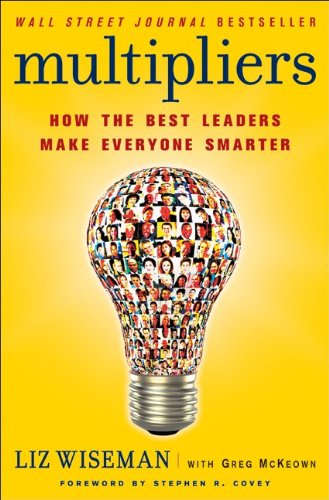by Liz Wiseman, with Greg McKeown. 2010. NY: HarperBusiness Publishers. 243 pages.
Reviewed by Diane Byington, Ph.D.
Everyone I’ve spoken with about this book relates an experience working for the two types of leaders discussed in these pages. Around some leaders (the Multipliers) they feel confident about their abilities and are willing to work their hardest, whereas around other leaders (the Diminishers) they feel inept and are unwilling to contribute more than the minimum required to keep the job. Unfortunately, I heard many more stories about the problems of working for a Diminisher than the joys of working for a Multiplier. The focus of this book is understanding the difference between these two leadership styles and learning how to move from being a Diminisher to a Multiplier.
A Multiplier is defined as a leader who is able to understand and solve hard problems rapidly, achieve goals, and adapt and increase the team’s capacity over time. A Diminisher is a leader whose team operates in silos, finds it hard to get things done, and despite having smart people, seems to not be able to do what is needed to reach goals.
Multipliers distinguish themselves from Diminishers through five disciplines. First, Multipliers attract and optimize talent by operating as Talent Magnets, attracting and deploying talent to its fullest regardless of who owns the resource. Conversely, Diminishers operate as empire builders, insisting that they must own and control resources to be more productive.
Second, Multipliers operate as Liberators, producing a climate that is both comfortable and intense. They remove fear and create the safety that invites people to do their best thinking, but they also create an intense environment that demands people’s best efforts. In contrast, Diminishers operate as tyrants, introducing a fear of judgment that has a chilling effect on people’s thinking and work.
Third, Multipliers operate as Challengers by seeding opportunities, laying down a challenge that stretches an organization, and generating belief that goals can be achieved. In contrast, Diminishers operate as know-it-alls, personally giving directives to showcase their knowledge. Whereas Diminishers set direction, Multipliers ensure that direction gets set.
Fourth, Multipliers operate as Debate Makers, driving sound decisions through rigorous debate. They engage people in debating the issues up front, which leads to decisions that people understand and can execute efficiently. Conversely, Diminishers operate as decision makers who tend to make decisions alone or within a small inner circle, but they leave the broader organization in the dark to debate the soundness of the decision instead of executing it.
Finally, Multipliers serve as Investors, delivering and sustaining superior results by maintaining high expectations across the organization, as well as providing necessary resources for success. They hold people accountable for their commitments. Diminishers, on the other hand, are micromanagers who drive results by holding on to ownership, jumping into the details, and directly managing results.
Multipliers get more than twice as much from their teams than Diminishers do, and team members are excited about doing the work. In these days of decreasing resources, helping Diminishers to become Multipliers can greatly enhance the productivity of teams and organizations.
The skills of Multipliers can be learned. The authors suggest that leaders take a 360 feedback assessment to learn where their strengths and shortfalls lie. Then, “top off a strength and neutralize a weakness.” Leaders rarely turn their biggest weaknesses into their biggest strengths. The truth is that you do not have to be fabulous at everything. You just can’t be bad. You need to move the weakness into a middle, acceptable zone, which frees you up to turn your modest strengths into towering strengths. Choose your strongest area among the five disciplines and build a deep and broad repertoire of practices that allows you to excel at this discipline.
Numerous suggestions are included for how to move across the continuum from Diminisher to Multiplier. Nearly everyone has some characteristics of each type in their repertoire. This book will help you sort through what you need to do, and encourage you on your path.
Wouldn’t it be great if everyone I spoke with about this book told me enthusiastic stories about the Multipliers they’ve worked for, and could hardly remember having worked for a Diminisher? If every leader were to read this book and take its message to heart, that could happen.
— Diane Byington is a writer and coach who consults with The Booth Company.

